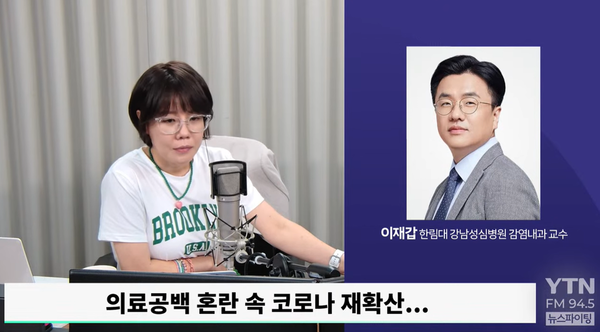The resurge of Covid-19, coming on top of a medical turmoil caused by the mass resignation of trainee doctors in protest of the government’s increase of the medical school enrollment quota, is adding to the concern about an even intensifying healthcare void.
Experts say the most severely ill patients need to be treated at tertiary general hospitals, but the lack of trainee doctors can make it difficult for them to receive proper care.
According to the Korea Disease Control and Prevention Agency (KDCA), the number of hospitalized Covid-19 patients increased from 226 in the third week of July to 472 in the fourth week of July, 869 in the first week of August, and 1,357 provisionally in the second week of August, marking a more than six-fold increase in a month.
Covid-19 pathogen detection rates have also increased.
According to the Korean Respiratory Virus Integrated Surveillance System (K-RISS), which conducts laboratory tests on patients with suspected acute respiratory viruses referred from medical institutions, the Covid-19 virus detection rate, which was 13.6 percent in the second week of July, rose to 24.6 percent in the third week, 29.2 percent in the fourth week, and more than tripled to 39.2 percent in the first week of August.

“The number of patients has increased more sharply than expected,” said Professor Lee Jae-gap of the Department of Infectious Diseases at Hallym University's Gangnam Sacred Heart Hospital on a YTN Radio talk show on Monday. “Due to the government-doctor conflicts, university hospitals operate without trainee doctors. A crisis could arise if the number of patients increases even a little.”
With a medical workforce shortage due to the resignations of junior doctors and specialists triggered by the conflict, Professor Lee worried that the most severely ill patients may not receive adequate treatment if the Covid-19 resurge is prolonged.
“We may not get to a pandemic situation,” Lee said. “However, if the epidemic escalates, high-risk people may be hospitalized, go to the ICU, or die. It doesn't have to be at the level of responding to a pandemic, but the challenge is how we protect these high-risk populations.”
“With the resignation of many trainee doctors, who used to play a significant role in critical care, the most critically ill patients are not being admitted to tertiary general hospitals and are being scattered to secondary hospitals,” he said. “They may get treatment but there are areas where they don't get the right care, which can cause invisible damage.”
Professor Lee was also concerned about the increasing number of doctors moving from rural areas to hospitals in the Seoul metro region, as the government promotes “specialist-oriented hospitals.” In the future, due to the lack of doctors, it could become difficult to receive Covid-19 treatment in rural areas, Lee added.
“Large hospitals in the greater Seoul area are starting to attract medical workers by raising salaries,” Lee said. “As a result, workers working hard in rural areas may feel they can go to the capital area. I think there will soon be a shortage of specialists nationwide.”
Lee continued, “(In rural areas), there are still dedicated doctors and nurses, but I'm worried that if the situation (of the Covid-19 resurge) worsens even a little bit, it could become quite difficult to get treatment.”
The infectious disease expert added that the government's failure to forecast the demand for Covid-19 drugs, including Paxlovid, has also contributed to a shortage of treatments available in the field.
“Last winter, the Covid-19 epidemic was negligible. The KDCA might have thought that the epidemic had subsided. However, since the winter epidemic was small, they should have thought that the number of cases could increase in the summer,” he said. “Worse yet, the Ministry of Economy and Finance approved a small budget for Covid-19 drugs, leading to a shortage of drugs.”
Lee continued, “We should have had a large-scale vaccination campaign in April, but there was a lack of publicity about the vaccination, and the media was not interested in Covid-19 while the health authorities could not raise the vaccination rate because they had no budget.”
From October, the KDCA will begin offering free Covid-19 vaccinations to people 65 and older, the immunocompromised, and hospitalized at vulnerable facilities.
Related articles
- Nearly one-third of Covid-19 vaccines discarded after expiration: lawmaker
- Korea to secure 260,000 Covid-19 treatment doses amid surge in cases
- Covid-19 cases in children surge 179% amid back-to-school concerns
- Korea's Covid-19 treatment shortage highlights dependence on imported drugs
- Resurgence of Covid-19 raises concerns amidst limited government action
- Pfizer notifies Seoul of plans to double Paxlovid's price, threatening Covid-19 treatment efforts
- Seoul to re-mobilize Covid-19 hub hospitals as ER overload intensifies
- Covid-19 linked to hearing loss risks in young adults
- Drug regulator sees ‘no problems’ in supply of test kits, cold medicines amid Covid-19 resurge
- Pfizer denies offering Seoul double Paxlovid’s supply price
- 30,000 unionized medical workers to launch general strike on Thursday
- Education minister downplays concerns over professor shortage amid medical school enrollment increase
- Korea’s healthcare system is on edge of precipice amid resurging Covid-19
- Hyundai Bioscience submits phase 3 trial plan for Xafty, targeting high-risk Covid-19 patients

